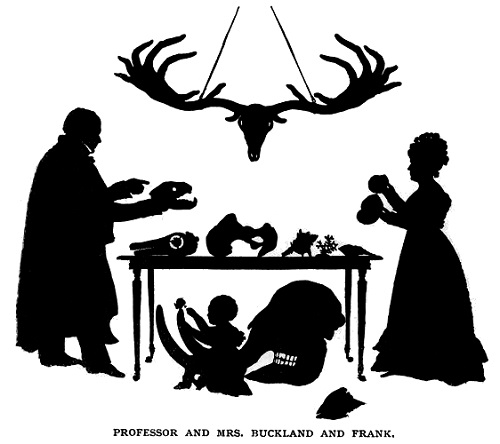As geologist and science writer Nina Morgan discovers, education begins at home
Morgan, N., Home schooling. Geoscientist 30 (10), 25, 2020
https://doi.org/doi: 10.1144/geosci2020-112, Download the pdf here
 In these days of lockdown with schools closed, the role of parents in educating their children has never been more important. Those struggling to keep the school lessons going and their children interested might well take some inspiration from William Buckland [1784 – 1856], the first Reader in Geology at Oxford University, and his wife, Mary [née Moreland; 1797 – 1857].
In these days of lockdown with schools closed, the role of parents in educating their children has never been more important. Those struggling to keep the school lessons going and their children interested might well take some inspiration from William Buckland [1784 – 1856], the first Reader in Geology at Oxford University, and his wife, Mary [née Moreland; 1797 – 1857].
Buckland's popular university lectures on geology and mineralogy included jokes, impersonations of extinct animals, as well as maps, drawings, fossils and mineral specimens. Field trips either on foot or horseback to local geological sites added extra spice. With the opening of the Great Western Railway route through Oxford, these were extended to locations as far away as Bath and Bristol, with Buckland giving a running commentary on the geology and scenery as the train passed through.
Mrs Buckland too contributed to her husband's educational efforts. As her eldest son, Francis Trevelyan (Frank) [1826 – 1880] recalled:
'... Not only was she a pious, amiable and excellent helpmate to my father; but being naturally endowed with great mental powers, habits of perseverance and order, tempered by excellent judgement, she materially assisted her husband in his literary labours, and often gave to them a polish which added not a little to their merit....
... there is hardly a fossil or bone in the Oxford Museum that has not her handwriting upon it."
Teaching tools
Contemporary descriptions of the Buckland household by Frank, his sister, Elizabeth Oke (aka 'Mrs Gordon') and their brother-in-law, George Bompas, husband of their sister, Mary Ann Scott (aka 'Mit') reveal that the Buckland parents applied the same innovative teaching methods to their own children as William Buckland did to his Oxford students. As Bompas revealed:
"In summer afternoons, after the early three o'clock dinner, Dr Buckland would drive out Mrs Buckland and their children in a carriage, known as the bird's nest to Bagley Wood to hunt for moles and nests ... or another day to Shotover, to dig in the quarries for oysters and gryphites... Some of the graver dons were perhaps a little scandalised by such vagrant proceedings, but how much happiness and wisdom were gathered in these excursions!"
And Mrs Gordon adds:
"The young people were always presented to the numerous learned foreigners and illustrious travellers who came to Oxford to see the Professor's world-famed collection of fossils and bones at the Clarendon; and at dessert in the evening they were told, shortly and graphically, what these great men were famous for."
Frank too, praises the active role their mother played in her children's education:
'... she did not neglect the education of her children, occupying her mornings in superintending their instruction in sound and useful knowledge. The sterling value of her labours, they now, in afterlife, fully appreciate and feel most thankful that they were blessed with so good a mother."
Success stories
Frank himself must be the most famous example of the success of the Bucklands' teaching techniques. He became an expert on fisheries and a prolific writer who went on, among other things, to author the best selling series of books, Curiosities of Natural History, which ran to 15 editions. A fluent and engaging speaker, in his lifetime he was regarded as one of the most successful popularisers of natural history around.
Although Mary Buckland's handwriting is no longer displayed prominently on the bones or fossils in the Oxford Museum – now known as the Oxford University Museum of Natural History – the educational legacy of both Buckland parents lives on. The Museum's very popular education programmes, public events and website continue to open the eyes of many to the wonders of geology and natural history.
So for all parents struggling with home schooling during this time of Covid-19, the Bucklands' success in home education, as busy working parents and without the aid of the internet, must surely be an inspiration. If they could turn out a Frank Buckland – so could you!
End notes
Sources include: Frank Buckland's Memoir in Treatise VI of the Bridgewater Treatises by William Buckland, Vol 1, 1858; The Life and Correspondence of William Buckland by Mrs Gordon, 1894; The Life of Frank Buckland by George Bompas, 1896; Lynn Barber, The Heyday of Natural History, 1980, ISBN 0-224-01448-x; Patrick John Boylan's 1984 PhD thesis on Buckland, available from Researchgate.net. I also thank Peter Lincoln for providing additional information.
Author
Nina Morgan is a geologist and science writer based near Oxford. Her latest book, The Geology of Oxford Gravestones, is available via www.gravestonegeology.uk